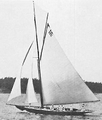
10 Metre (keelboat)
Encyclopedia
The International Ten Metre Class is a construction class, meaning that the boats are not identical but are all designed to meet specific measurement formula, in this case International Rule. At their heyday, Metre Classes were the most important group of international yacht racing classes, and they are still actively raced around the world. "Ten" in class name does not, somewhat confusingly, refer to length of the boat, but product of the formula; 10mR boats are, on average, 16.5 meters long.
and 1920 Olympics
.
The International Rule was set up in 1907 to replace earlier, simpler handicap system which were often local or at best, national, and often also fairly simple, producing extreme boats which were fast but lightly constructed and impractical. The rule changes several times in history. About 20 boats were ever build.

where

where

History
The 10mR was used as an Olympic Class during the 1912Sailing at the 1912 Summer Olympics
The sailing at the 1912 Summer Olympics consisted of a total of four sailing classes . For each class two ordinary races were scheduled from July 19, 1912 to July 27, 1912 of the coast of Nynäshamn...
and 1920 Olympics
Sailing at the 1920 Summer Olympics
The sailing at the 1920 Summer Olympics consisted of a total of 16 sailing classes . Two of these classes finally did not have entries. For each class three races were scheduled from 7 July 1920 to 9 July 1920 of the coast of Ostend North Sea. On 10 July 1920 sail-off races could be held.Two...
.
The International Rule was set up in 1907 to replace earlier, simpler handicap system which were often local or at best, national, and often also fairly simple, producing extreme boats which were fast but lightly constructed and impractical. The rule changes several times in history. About 20 boats were ever build.
1907 Rule
Used from 1907–1920
where
-
 = waterline length (LWL)
= waterline length (LWL) -
 = beam
= beam -
 = chain girth
= chain girth -
 = difference between girth and chain
= difference between girth and chain -
 = sail area
= sail area -
 = freeboard
= freeboard
1919 Rule
Used from 1920–1933
where
-
 = waterline length (LWL)
= waterline length (LWL) -
 = chain girth
= chain girth -
 = difference between girth and chain
= difference between girth and chain -
 = sail area
= sail area -
 = freeboard
= freeboard
1912 (1907 rule)

| Rank | Country | Helmsman | Crew |
| HELLSTRÖM, Carl Ludwig | WALLERIUS, Eric G. WALLERIUS, Harald LUNDEN, Humbert NYBERG, Herman ROSENWÄRD, Harry ISBERG, Paul ERICSSON, Filip |
||
| WAHL, Harry | BJÖRKSTEN, Waldemar BJÖRNSTRÖM, Jacob Karl BRENNER, Bror Benedikt FRANCK, Allan LINDH, Erik PEKKALAINEN, Adolf Aarne |
||
| BELOSELSKY, Esper | BRASCHE, Ernest PUSCHNITSKY, Nikolaï RODIONOV, Aleksandr SCHOMAKER, Iossif STRAUCH, Filip LINDBLOM, Karl |
||
| 4 | LINDEN, Einar | LINDHOLM, Karl WALLER, Erik BOTHEN, Björn BOTHEN, Bertil FORSBERG, Wilhelm |
|
1920 (1907 rule)
Only one boat at the starting line| Rank | Country | Helmsman | Crew |
| HERSETH, Erik Johan | HOLTER, Sigurd NIELSEN, Ingar JAMVOLD, Petter JAMVOLD, Gunnar JUELL, Claus |
||
1920 (1919 rule)
Only one boat at the starting line| Rank | Country | Helmsman | Crew |
| ARENTZ, Charles Archer | GILBERT, Willy GJERTSEN, Robert SEJERSTED, Arne SCHJÖTT, Halfdan SCHJÖTT, Trygve FALKENBERG, Otto Gabriel Grubbe |
||

